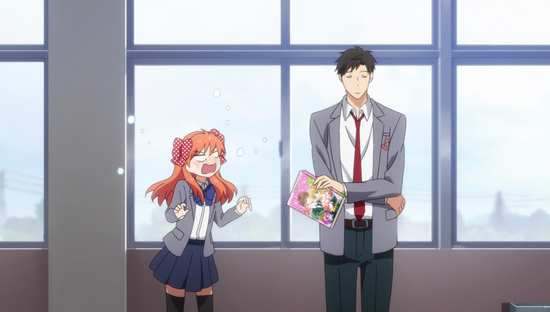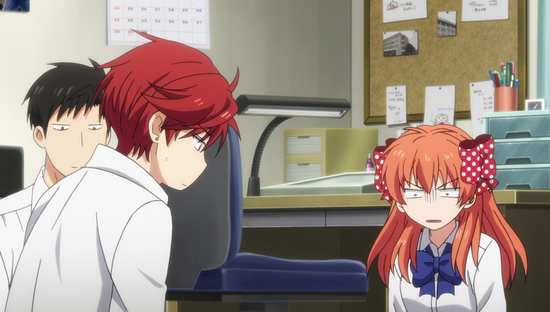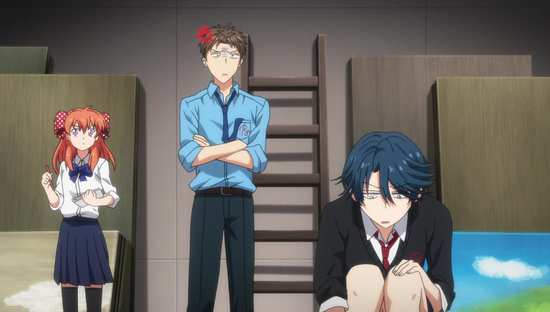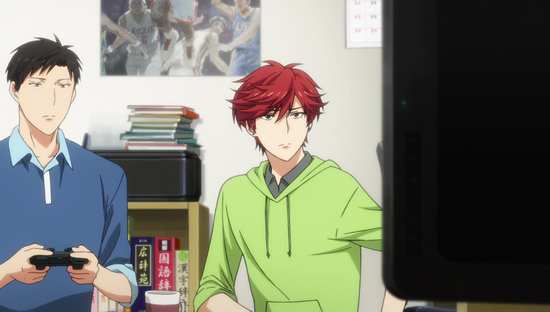Review for Monthly Girls' Nozaki-kun
Introduction
I really do know how to pick ‘em. Whenever there’s a clash of anime, more than one title regarding a particular subject, I always wind up choosing the worst of them to watch. I think it’s an attraction to prosaic names. There were a bunch of shows about fighter planes way back, and most people were raving about Yukikaze (which I still haven’t seen by the way), there was a lot of affection for Stratos 4, but I went for Area 88, which is meh. A couple of years ago, it was all Oda Nobunaga. I ignored Nobunagun, the gender bending Ambition of Oda Nobuna, and Battle Girls: Time Paradox, and instead went for Nobunaga the Fool, after all, it had his name properly in the title. It was the worst of the lot. So when one season had two shows about the creation of manga comics, I had to go for The Comic Artist and His Assistants, when everyone else was acclaiming Monthly Girls Nozaki-kun as the best thing since sliced bread. All that The Comic Artist and His Assistants is about is a perverted artist who likes drawing girls in their underwear. Monthly Girls Nozaki-kun is about so much more...
Chiyo Sakura has long nursed a crush on fellow student, the tall and taciturn Umetaro Nozaki. It’s now finally time to confess all, put her cards on the table and tell him how much she loves him. Only she gets a little tongue-tied and tells him that she’s a big fan instead. That normally wouldn’t be a problem, except Nozaki is the kind of guy who actually has fans. He promptly gives her an autograph. Chiyo tries again; she tells him that she always wants to be with him. So naturally he takes her home... and puts her to work. Given that Chiyo is in the art club, Nozaki thinks that she’s asked for a job, understandable given that Umetaro Nozaki is actually a manga artist, and under the pen-name Sakiko Yumeno creates romance stories for young female audiences. What isn’t understandable is that given his ability to create romance in manga form, he’s so utterly dense about it in real life. Working as one of Nozaki’s assistants, maybe Chiyo will have chance to find out why...
12 episodes of Monthly Girls Nozaki-kun plus extras are presented across two Blu-rays from MVM. The show is also available on DVD, and on a Limited Edition combo pack with the soundtrack on 3 CDs.
Disc 1
1. This Love is Being Turned into a Shojo Manga
2. Say Hello to the New Heroine
3. Violence vs. The Prince
4. There Are Times When Men Must Fight
5. The Man Who Envisions Love
6. I’ll Cast a Spell on You
7. The Manga Artist’s Brain, Nozaki-kun
8. The Prince (Girl) of the School’s Problems
9. Do You Have Enough Excitement?
Disc 2
10. What’s Strengthened is Our Bond and Our Reins
11. Let’s Rice
12. If This Feeling Isn’t Love, Then There is No Love in the World
Picture
Monthly Girls Nozaki-kun gets a 1.78:1 widescreen 1080p transfer. A modern show given a high definition presentation doesn’t really invite much criticism, and Monthly Girls’ transfer to Blu-ray is nigh on impeccable. The image is clear and sharp, the colours are strong and consistent, the animation is fluid and without issue, detail levels are excellent, and there isn’t even the annoyance of digital banding in this bright and colourful show. You can enjoy every frame of Monthly Girls Nozaki-kun without complaint. It’s a warm and vivid show, just as you would expect from an anime comedy, and the character designs are suitably quirky and memorable.
Sound
You have the choice between PCM 2.0 Stereo English and Japanese with translated English subtitles and a signs only track. You can pick any combination of the audio and subtitle streams from the main menu or pop-up menu, but they remain locked during playback from your remote control. And there’s no watching the show with subtitles off completely. As this disc was authored in Australia, the subtitles are of the discreet white font variety, rather than Sentai’s usual big yellow. I was happy with the original language version, the actors are perfectly suited to their roles, and as this is a primarily dialogue focused piece; the stereo isn’t called on for much in the way of action. The subtitles are timed accurately and are free of typos. I gave the dub a try and it was pretty good for a Sentai dub, in that I wasn’t immediately forced to turn it off. The Collector’s Edition of this from MVM has three soundtrack CDs, and I was occasionally minded to listen to the music. This is one of the shows where the music is subliminal to the show, you’re very rarely aware of it motivating the comedy, but when I listened for it, it seemed agreeable enough, although your mileage may vary when it comes to its worth as a separate soundtrack. I am reviewing the standard Blu-ray if that’s any indication of my opinion.
Extras
You get two discs in a Blu-ray Amaray, one on either inner face. The inner sleeve has character art, and an episode listing. After unskippable logos, you’re taken to a static menu screen. From the audio and subtitle options, and the audio format, it becomes clear that while the materials might have travelled via Sentai Filmworks in the US, Hanabee Entertainment have localised and re-authored the discs for Region B Australia, and MVM are taking advantage of those discs in the UK. Consequently the usual translated English credit scrolls that Sentai add have in this case been removed.
The extras are all on disc 2 and of greatest interest will no doubt be the Nozaki-kun Shorts, 6 more mini episodes that together add another episode worth of story.
1. Is That Handsome Boy Just a Friend or Her Boyfriend Part 1 (3:04)
2. Is That Handsome Boy Just a Friend or Her Boyfriend Part 2 (3:08)
3. The Correlation Chart That Corrects Everything (3:19)
4. It’s Summer! It’s the Ocean! It’s the Training Camp! (3:42)
5. Me or the Sun... Which Do You Think Shines More? (3:00)
6. This Happening is Being Turned Into a Shojo Manga (3:03)
Just like the series, you can watch these dubbed or with subtitles.
You get 3:09 of Japanese Promos for the show, 0:55 of Japanese Commercials, and finally the textless credits.
Conclusion
The bottom line when it comes to reviewing any comedy, is whether it’s funny or not. Monthly Girls Nozaki-kun is hilarious. It’s never less than funny, and at some points I was laughing so much that it hurt. It may not be the most consistent of comedies, but even at its weakest, it’s never dull. But I have to admit straight up that it plays to a certain audience, one that has enough experience with manga and anime, especially shojo manga (stories about young love created for young female audiences) that there is some familiarity with the character and story tropes that this show plays with and subverts. Fortunately it’s such a broad and common manga genre that it’s unlikely that any anime fan will have issues here, but if you’ve never seen an anime or read a manga before, this probably isn’t the show to start with.
It starts off just like a shojo manga, with the series heroine Chiyo Sakura finally working up the gumption to confess her feelings to the one boy in the school that she has thus far adored. It’s just that when she comes to the crucial, blush filled awkward moment, she doesn’t choose her words carefully enough, and winds up with an autograph from Umetaro Nozaki. A second attempt gets her hired as his assistant. He actually creates shojo manga under the pen name Sakiko Yumeno, and Chiyo’s art skills are just what he needs to lighten the work load.
It’s here that the obvious joke in the show becomes clear. Nozaki writes about young teen romance for female audiences, but he’s blissfully oblivious to Chiyo’s interest in him. It quickly becomes apparent that the world of teen romance in manga form bears little resemblance to the real world, but Nozaki’s denseness goes beyond even that. When it comes to the stories he writes, inspiration rarely comes to him out of the blue, and instead he looks to the relationships of the people around him for inspiration. That’s the other students in school, some of who also help him with his manga. The last thing that he needs is the guy in charge of backgrounds, or of atmospheric art, or the guy with the eraser to find out that he’s lifting from their lives for his stories, so he’s come up with the effective solution of reversing their genders in the comic.
But these are the most dysfunctional and illogical relationships and characters that he could have considered as inspiration. The inspiration for Nozaki’s heroine comes from Mikoshiba, who helps him with atmospheric art. He’s an extroverted introvert, if there could be such a thing. He’s loud, he’s brash, and he’s constantly flirting with girls, saying the most outrageous things, only to be deathly embarrassed by his words not long after. But he’s actually uncomfortable around people and hides behind that extrovert personality. His best friend is a girl called Kashima, a tall, elegant, boyish girl who is quickly adopted by the drama club as their star for all the princely roles. She’s pretty dense too when it comes to the drama club president, Hori. He tolerates her for her talent, but not for her lackadaisical attitude, or the adoring hangers on that follow her. She thinks he’s a little sweet on her; he’s liable to resort to violence whenever she ditches the club. Hori is the one who helps Nozaki with his backgrounds.
Then there is Sakura’s friend Yuzuki, an even greater dense tomboy of a girl, who loves playing sport, but has no sense of team spirit. Her idea of basketball is to run around with the ball, destroying the opposite team. The school team play with her to teach everyone how to deal with selfish players. One player on the receiving end of Yuzuki’s tactics is Wakamatsu who winds up helping Nozaki with screen-tones. He’s constantly irked to the point of insomnia by Yuzuki, but the only thing that can soothe his frustrations is the voice of the school glee club Lorelei, a singer with an angelic voice. Wakamatsu has no idea that this voice actually belongs to Yuzuki.
These are the people in school that inspire Nozaki, but just characters aren’t enough. Nozaki needs storylines and situations, so he often goes looking for research, and indeed winds up dragging Sakura in on his plans, such as when he tries to come up with a romantic way for two people to ride a bike, in a country where doubling up on a single bike is against the law, or when Yuzuki invites Wakamatsu to the movies, he demands a blow-by-blow report, or figuring out the best way for a boy and a girl to run through the rain and more.
Naturally with a story about a manga creator we get some insight into the creation process, although thankfully it isn’t as convoluted and extended as that in Bakuman. But we do learn the stress that Nozaki has with his editor, and how much worse it once was with his first editor. These little insights and commentary on the manga industry are fascinating and funny, but the real joy is in the character comedy, and with such a grouping of dense ‘idiots’, with Sakura playing the straight man to them all, it’s a rich cornucopia of humour.
It’s always hard to review a comedy without just listing all the funny bits, and even if I do point out the moment where Nozaki pushes Kashima on a trolley, chased by most of the girls in the school as the moment where I had to press pause so I could laugh myself out before resuming, lest I miss the following gags, it’s meaningless to anyone without the context of watching the show. So all I can do is reiterate that all you need is a little experience with the shojo genre, watch something like Fruits Basket or borrow a couple of suitable manga from your local library, and you’ll be primed to be richly entertained by Monthly Girls Nozaki-kun, and it’s a show that you’ll come back to time and again. Of course on Blu-ray it’s all the more attractive.














Your Opinions and Comments
Be the first to post a comment!